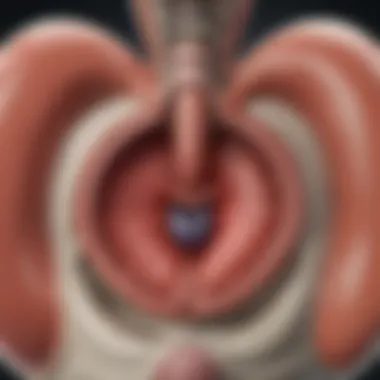Understanding Mitral Regurgitation Pathophysiology


Intro
Mitral regurgitation is a significant cardiac condition that affects the normal flow of blood through the heart. Understanding its pathophysiology provides insight into the disease mechanisms and the potential therapeutic avenues that can be explored.
This discussion will focus on several key aspects, including the anatomy of the mitral valve, the physiological consequences of improper closure, and the impact of various etiologies. Furthermore, the implications for hemodynamics, diagnostic strategies, and treatment options will be comprehensively reviewed. Such insights are vital for students, researchers, and healthcare professionals engaged in cardiac care.
Key Findings
Major Results
The primary finding in the study of mitral regurgitation is that the improper closure of the mitral valve leads to a backflow of blood into the left atrium during ventricular contraction. This results in several hemodynamic changes, including volume overload of the left atrium and increased pressure within it. In time, these changes contribute to the development of atrial dilation, which can further exacerbate the regurgitation and increase the risk of arrhythmias.
The comprehensive exploration of mitral regurgitation identifies several notable etiologies: degenerative changes, rheumatic disease, and ischemic heart disease predisposing individuals to this condition. Each etiology has distinct anatomical and physiological implications, affecting symptoms and treatment options.
Discussion of Findings
The study reveals how mitral regurgitation has a multifactorial nature. The anatomical structure of the valve, including the leaflets, chordae tendineae, and papillary muscles, plays a crucial role. Any degeneration or damage to these components can lead to impaired function. Additionally, the interaction between left ventricular function and mitral valve competency is significant. In a normal state, the left ventricle and mitral valve function in a coordinated manner. However, in cases of regurgitation, this coordination is disrupted.
The implications for hemodynamics are profound. The increased preload due to backflow can enhance stroke volume initially, but over time, it can lead to heart failure. This highlights the importance of timely diagnosis and management to prevent adverse outcomes.
Methodology
Research Design
This article utilizes a comprehensive review methodology, gathering data from various studies and clinical observations on mitral regurgitation. Such a systematic approach allows for a nuanced understanding of this condition and its effects.
Data Collection Methods
Data was collected from peer-reviewed journals, clinical studies, and academic resources. Keywords like "mitral valve" and "regurgitation" were pivotal in locating relevant literature. This process ensured a thorough examination of both clinical perspectives and underlying mechanisms.
Preamble to Mitral Regurgitation
Mitral regurgitation is an important cardiac condition affecting numerous individuals around the world. Understanding this topic is crucial for healthcare practitioners, researchers, and educators alike in their efforts to provide optimal patient care. The improper closure of the mitral valve results in the backflow of blood into the left atrium during ventricular contraction. This leads to a range of complications, which can significantly impact patient outcomes.
The importance of this section lies in delineating the various aspects of mitral regurgitation, both from an anatomical and physiological perspective. It allows readers to grasp the broader implications related to patient management and prognosis. Moreover, insight into this condition helps guide future research and clinical practices.
Definition and Overview
Mitral regurgitation can be defined as a functional or structural disorder of the mitral valve that causes retrograde blood flow. During systole, when the left ventricle contracts, some blood flows back into the left atrium instead of moving into the aorta. This abnormal backflow can be acute or chronic, depending on the underlying cause.
The condition can arise from various etiological factors, including degenerative changes in the valve, inflammatory processes, or ischemic heart disease. Symptoms may range from mild to severe, sometimes unnoticed in earlier stages, leading to delayed diagnosis.
Epidemiology
Epidemiologically, mitral regurgitation is relatively common. It is often seen in both the adult and elderly population. Various studies suggest that its prevalence increases with age, with significant findings in those over 75 years old. Moreover, it is important to note that mitral regurgitation can affect both genders, although some studies indicate males may be at a higher risk.
Recent research emphasizes the need for regular screening, especially in populations at risk, to better manage and treat the condition. The understanding of epidemiological trends enriches our knowledge and informs healthcare policies to ensure efficient resource allocation for patient care.
Anatomy of the Mitral Valve
The anatomy of the mitral valve holds significant importance in understanding mitral regurgitation. Dysfunction in this valve can lead to serious hemodynamic consequences. By studying the mitral valve's structure and function, one can gain insights into how abnormalities lead to pathological conditions like mitral regurgitation.
Structure of the Mitral Valve
The mitral valve is a complex structure located between the left atrium and the left ventricle of the heart. It consists of two leaflets—known as the anterior and posterior leaflets. These leaflets are thin yet sturdy, allowing them to open and close effectively with the heart's pumping action. The leaflets are shaped somewhat like a parachute. They attach to the chordae tendineae, which are string-like structures connecting the leaflets to the papillary muscles embedded in the ventricular wall.
The valve's annulus, a fibrous structure that encircles the valve, plays a crucial role. It provides a base from which the leaflets emerge. The annulus can change dimensions during the cardiac cycle, which contributes to the valve's overall functionality. The structure's integrity is vital, as any degeneration or dilation can contribute to regurgitation and other complications.
The supporting structures, including the left atrium and ventricle, also influence the mitral valve's operation. Alterations in these components can result in further complications, highlighting the mitral valve's dependent nature.
Function of the Mitral Valve
The primary function of the mitral valve is to control blood flow from the left atrium to the left ventricle. During diastole, the valve opens to allow blood to fill the left ventricle. In systole, the valve closes tightly to prevent backflow into the atrium when the left ventricle contracts. This function ensures that the blood flows efficiently to the aorta and then to the rest of the body.


Key aspects of the mitral valve function include:
- Regulation of Blood Flow: It prevents regurgitation and maintains unidirectional blood flow.
- Support of Cardiac Cycle: Its opening and closing are timed precisely with the cardiac cycle to maintain optimal hemodynamics.
- Relationship with Surrounding Structures: The proper functioning also depends on the state of the surrounding cardiac structures. Any dysfunction can significantly affect the valve's effectiveness.
Understanding the anatomy and function of the mitral valve is essential in recognizing how structural changes can lead to mitral regurgitation. A detailed comprehension of these features provides a foundation for further discussions regarding its pathophysiology, causes, and clinical manifestations.
"Knowledge of the mitral valve's anatomy and function is fundamental in diagnosing and managing mitral regurgitation, guiding clinical decisions and interventions."
This understanding is critical, especially for clinicians, researchers, and advanced students in the field of cardiology, as they navigate through the complexities of this prevalent cardiac condition.
Pathophysiology of Mitral Regurgitation
Understanding the pathophysiology of mitral regurgitation is critical for comprehending how this condition leads to significant clinical consequences. This subsection is crucial as it outlines the underlying mechanisms contributing to mitral regurgitation, which reflects the functional implications of the anatomical structures involved. Analyzing the pathophysiology helps to clarify the interplay between regurgitation mechanisms, hemodynamic changes, and the body's response, which ultimately informs clinical management and outcomes.
Mechanisms of Regurgitation
Mitral regurgitation occurs when the mitral valve fails to close properly during ventricular contraction. Several mechanisms contribute to this failure:
- Degenerative Disease: This is often related to myxomatous degeneration of the valve leaflets. This can lead to elongation of the chordae tendineae and consequently, valve prolapse.
- Rheumatic Heart Disease: Previous rheumatic fever can damage the mitral valve, leading to stenosis or regurgitation.
- Infective Endocarditis: This infection may cause vegetations that interfere with proper valve closure.
- Ischemic Heart Disease: Myocardial infarction can result in papillary muscle rupture, leading to acute mitral regurgitation.
These mechanisms can affect individual patients in various ways, leading to different severity levels and requiring personalized management strategies.
Hemodynamic Changes
Mitral regurgitation causes significant hemodynamic changes within the heart. The backflow of blood into the left atrium elevates atrial pressure during ventricular systole. Key changes include:
- Increased Left Atrial Volume: The volume overload caused by regurgitation leads to left atrial enlargement over time, contributing to atrial fibrillation risk.
- Increased Pulmonary Venous Pressure: This can lead to pulmonary congestion and symptoms of heart failure.
- Decreased Cardiac Output: The effective forward flow of blood to the systemic circulation may be compromised, particularly in severe cases of regurgitation.
These hemodynamic alterations are essential to monitor, as they directly influence the symptoms experienced by patients and the overall management of the condition.
Compensatory Mechanisms
The body attempts to adapt to the changes precipitated by mitral regurgitation through various compensatory mechanisms. These include:
- Left Atrial Hypertrophy: In response to increased volume, the left atrium undergoes hypertrophy to accommodate the higher volume of blood.
- Neurohormonal Activation: The renin-angiotensin-aldosterone system may be activated, leading to fluid retention, which may worsen heart failure symptoms.
- Increased Heart Rate: The body may also respond to decreased cardiac output by increasing heart rate, attempting to maintain adequate perfusion.
While these compensatory mechanisms can initially stabilize the patient, over time, they may lead to further cardiac dysfunction and complications, emphasizing the need for timely intervention.
Ultimately, understanding the pathophysiology of mitral regurgitation allows healthcare professionals to make informed decisions regarding management and treatment, aligning clinical practices with the underlying biological principles.
Etiology of Mitral Regurgitation
Understanding the etiology of mitral regurgitation is crucial for comprehending this condition's underlying mechanisms and determining appropriate treatment options. The etiology encompasses a range of factors, including anatomical abnormalities, degenerative changes, and other systemic conditions. Recognizing these factors not only guides clinical decision-making but also provides insights into potential preventative strategies.
Acute Causes
Acute mitral regurgitation often arises suddenly due to serious complications. One common cause is myocardial infarction, specifically in situations where the coronary artery that supplies blood to the heart muscle is obstructed. This can weaken the heart's structure, particularly affecting the papillary muscles that support the mitral valve.
Other acute causes include:
- Rupture of the chordae tendineae: These are strong, string-like structures that connect the papillary muscles to the mitral valve flaps. When they tear, the valve cannot close properly, leading to significant backflow of blood.
- Infective endocarditis: This infection of the heart valves can cause acute mitral regurgitation through valve destruction or severe accumulation of vegetations.
Immediate recognition and response to these acute causes are essential to mitigate further cardiac complications.
Chronic Causes
Chronic mitral regurgitation develops over a longer period and is more frequently seen in clinical practice than the acute form. Various underlying conditions contribute to the chronicity of the condition. Common chronic causes include:
- Degenerative mitral valve disease: This entails gradual wear and tear of the valve structures, often presenting as degenerative changes in older populations.
- Rheumatic heart disease: Following rheumatic fever, the mitral valve can become scarred and distorted, leading to regurgitation.
- Dilated cardiomyopathy: This cardiac condition can stretch the ventricles, causing secondary mitral regurgitation as the valve's anatomy is altered due to ventricular enlargement.
Other notable chronic causes include:
- Congenital malformations of the mitral valve, which may not manifest until adulthood.
- Connective tissue disorders, such as Marfan syndrome, which can lead to structural abnormalities affecting the valve's integrity.
In chronic cases, the body may adapt to the altered hemodynamics for a while. However, over time, this can lead to significant complications like heart failure or atrial fibrillation if not monitored and managed appropriately. Understanding these chronic causes aids clinicians in developing tailored management plans and improving patient outcomes.


Clinical Manifestations
Understanding the clinical manifestations of mitral regurgitation is vital. These signs and symptoms help clinicians to identify the condition early and determine the severity. The manifestations reflect how the backflow of blood affects the heart and overall health of the patient. As mitral regurgitation progresses, the heart must adjust to increased volume load. This can lead to significant changes in clinical presentation. Recognizing these manifestations allows for timely interventions and personalized treatment strategies.
Symptoms
The symptoms of mitral regurgitation can vary greatly among individuals. Some may experience no symptoms for a long time, while others may have noticeable discomfort. Common symptoms include:
- Shortness of breath: Often occurs during physical activity or when lying flat.
- Fatigue: A feeling of constant tiredness can be prevalent.
- Palpitations: Sensation of irregular heartbeats or rapid beats may occur.
- Swelling in the legs or abdomen: Related to heart failure caused by the condition.
- Chest pain: Although not as common, some patients report pain, especially if they have concurrent coronary artery disease.
These symptoms can significantly affect quality of life and are indicative of the severity of the condition. Patients should be aware that the absence of symptoms does not necessarily indicate a lack of serious underlying pathology.
Signs on Examination
Physical examination can reveal important signs that hint at mitral regurgitation. Clinicians usually perform several assessments to better understand the patient's condition. Key examination findings include:
- Heart murmur: A high-pitched or blowing sound during heartbeats is often present.
- Displaced apex beat: Due to left ventricular enlargement, the apex beat may be felt in an abnormal location.
- Signs of heart failure: When observing the extremities, swelling or edema may be noted.
- Auscultatory findings: A third heart sound or gallop rhythm may indicate increased filling pressure in the heart due to regurgitation.
"Identifying the clinical manifestations of mitral regurgitation is crucial for early diagnosis and management of heart-related complications."
Overall, thorough evaluation of symptoms and physical signs helps in understanding the impact of mitral regurgitation on the patient’s health. This assessment can direct follow-up strategies and possible therapeutic options.
Diagnosis of Mitral Regurgitation
Diagnosing mitral regurgitation is vital for effective management of the condition. Timely and accurate diagnosis leads to interventions that can significantly improve patient outcomes. Early detection can help mitigate symptoms and prevent complications associated with the disease. Clinicians often rely on imaging techniques to assess the structure and function of the mitral valve. Understanding the diagnostic approaches is essential for healthcare professionals, as it provides insight into when to initiate treatment or further testing.
Echocardiography Techniques
Echocardiography stands as the cornerstone for diagnosing mitral regurgitation. This non-invasive imaging method uses ultrasound to create images of the heart, allowing for a real-time view of the mitral valve. There are several echocardiographic techniques commonly utilized:
- Transthoracic Echocardiography (TTE): This is the initial diagnostic test. TTE is a simple, non-invasive procedure that provides essential information about the anatomy of the mitral valve and helps assess the severity of regurgitation.
- Transesophageal Echocardiography (TEE): TEE offers a more detailed view, particularly beneficial in cases where TTE results are inconclusive. This method involves passing a probe down the esophagus to obtain closer images of the heart. TEE is more sensitive and can identify cases of mitral regurgitation missed by TTE.
- Doppler Echocardiography: This is essential for evaluating blood flow. By measuring the velocity of blood across the mitral valve, Doppler techniques allow clinicians to assess the severity of regurgitation quantitatively.
These echocardiographic methods contribute to a comprehensive understanding of mitral regurgitation and its hemodynamic consequences. They also help monitor the effectiveness of treatment over time.
Additional Imaging Modalities
While echocardiography is crucial, there are other imaging modalities that may support the diagnosis of mitral regurgitation.
- Cardiac MRI: This imaging technique provides high-resolution pictures of cardiac structures. It is particularly useful for assessing heart chamber sizes and function, offering a broader perspective on how mitral regurgitation affects overall cardiac health.
- Computed Tomography (CT): CT scans can visualize the mitral valve and surrounding structures. They help in identifying any anatomical abnormalities contributing to regurgitation.
- Chest X-ray: Though less specific, a chest X-ray can show heart size and pulmonary congestion, which may indicate the presence of mitral regurgitation.
Each imaging technique plays a distinct role in confirming the presence of mitral regurgitation, guiding treatment decisions. A combination of these methodologies may often provide the best diagnostic clarity.
The integration of multiple imaging techniques can better inform clinical decisions, leading to improved management of mitral regurgitation.
Management of Mitral Regurgitation
The management of mitral regurgitation is a critical aspect of care for patients with this condition. Effective management strategies can significantly influence clinical outcomes, improve quality of life, and reduce the complications associated with the disease. A multifaceted approach involving both medical and surgical interventions exists, depending on the severity of regurgitation, symptoms, and overall health of the patient. Therefore, understanding the various management options is essential for healthcare providers.
Medical Management
Medical management of mitral regurgitation typically focuses on alleviating symptoms and preventing disease progression. This often involves the use of medications that address heart function and control blood pressure, among other parameters. Commonly prescribed medications include:
- Diuretics: These help reduce fluid buildup, alleviating symptoms of heart failure.
- ACE Inhibitors: Angiotensin-converting enzyme inhibitors can lower blood pressure and decrease the heart's workload.
- Beta-Blockers: Useful in managing heart rate and rhythm abnormalities.
- Anticoagulants: Patients may require blood thinners to reduce the risk of thromboembolic events, particularly if atrial fibrillation is present.
The choice of medication must be tailored to the individual patient, considering their overall health, other comorbidities, and response to treatment. Regular follow-ups are necessary for monitoring the effectiveness and side effects of medication therapy. Furthermore, lifestyle modifications, including dietary changes, regular exercise, and smoking cessation, are recommended to support medical management.
Surgical Interventions
Surgical intervention may become necessary for patients with significant mitral regurgitation who experience symptomatic heart failure or structural heart changes. The primary surgical options include:
- Mitral Valve Repair: This is often preferred due to favorable outcomes and preservation of the patient’s own valve. Techniques may include annuloplasty, where the valve ring is tightened, or reconstruction of the valve leaflets.
- Mitral Valve Replacement: In cases where repair is not feasible, replacement with either a mechanical or biological valve may be warranted. The decision between the two types depends on patient age, lifestyle, and medical history.
The timing of surgical intervention is crucial. Patients should be monitored closely, and surgery typically occurs when symptoms worsen or if echocardiographic criteria indicate a decline in heart function.
The choice to proceed with surgical options should be based on a thorough evaluation of risks, benefits, and patient preferences.


In summary, the management of mitral regurgitation encompasses a wide range of strategies. Medications can help control symptoms and improve heart function, while surgical options are vital for those with more severe disease. Collaboration between patients and healthcare providers is essential to tailoring the approach to individual needs.
Prognosis and Outcomes
Understanding the prognosis and outcomes of mitral regurgitation is essential for clinicians and researchers alike. Prognosis refers to the likely course and outcome of a disease, which is influenced by several factors pertaining to the patient's health and the specific characteristics of the mitral regurgitation itself. It is of utmost importance as it guides treatment options and informs patients regarding their long-term health prospects.
In mitral regurgitation, long-term outcomes are determined by the severity of the condition, its rate of progression, and the patient's response to treatment. Regular monitoring is critical and can aid in timely interventions.
Long-Term Outcomes
Long-term outcomes for patients with mitral regurgitation can vary significantly. Generally, individuals with mild to moderate regurgitation may demonstrate a relatively stable course without significant morbidity. Those with moderate to severe regurgitation, however, are at a higher risk for complications, such as heart failure or atrial fibrillation.
Survival rates often increase if patients undergo surgical correction before the onset of heart failure symptoms. For instance, patients who receive elective mitral valve surgery for severe regurgitation before heart dysfunction starts have a favorable prognosis. Research suggests that these patients often attain better quality of life post-surgery, with reduced symptom burden and improved heart function.
"Surgical intervention at the appropriate stage can dramatically improve outcomes for patients with significant mitral regurgitation."
Factors Influencing Prognosis
Multiple factors can influence the prognosis of mitral regurgitation, including:
- Severity of Regurgitation: The degree of backflow impacts overall heart function, influencing long-term outcomes.
- Age and Comorbidities: Younger patients with fewer comorbid conditions generally fare better.
- Response to Treatment: How an individual responds to medication or surgery significantly affects prognosis.
- Functional Status: Employing tools like the New York Heart Association (NYHA) classification can provide insights into functional limitations and their implications for prognosis.
- Time to Surgical Intervention: Prompt treatment before the development of complications can lead to better outcomes.
Understanding these factors is critical as they can drive clinical decision-making and patient education. Overall, prognosis is not static; it evolves based on ongoing assessment and interventions, highlighting the need for a personalized approach in managing mitral regurgitation.
Complications Associated with Mitral Regurgitation
Mitral regurgitation can lead to a range of complications that significantly impact patient health. Understanding these complications is crucial not only for the management of the condition but also for improving patient outcomes. The complications can stem from both the direct effects of the regurgitation and the compensatory mechanisms the body employs to maintain function.
Heart Failure
Heart failure is a predominant complication linked to mitral regurgitation. As the condition progresses, the left atrium experiences increased volume overload. This overload occurs because blood flows backward from the left ventricle during systole, causing the left atrium to dilate. Over time, this dilation can lead to a decrease in contractile function.
The symptoms of heart failure, such as shortness of breath, fatigue, and edema, may arise as the heart struggles to meet the body’s demands. In addition, persistent volume overload may result in pulmonary congestion, which can deteriorate quality of life.
Risk Factors for Heart Failure in Mitral Regurgitation
- Severity of Regurgitation: More severe cases correlate with a higher risk.
- Comorbid Conditions: Conditions like hypertension may exacerbate the situation.
- Left Ventricular Function: Impaired function significantly increases heart failure risk.
Management strategies for heart failure due to mitral regurgitation often involve both medical and surgical approaches, focusing on relieving symptoms and preventing further complications.
Atrial Fibrillation
Atrial fibrillation (AF) represents another common complication associated with mitral regurgitation. The enlargement of the left atrium caused by chronic volume overload often disrupts the normal electrical activity of the heart. When the left atrium dilates, the structural changes can lead to fibrotic tissue development, which predisposes patients to arrhythmias, particularly atrial fibrillation.
AF can have considerable consequences, such as an increased risk of stroke and worsening heart failure. Patients may experience palpitations, dizziness, or even syncope as a result of this irregular heartbeat.
Significance of Atrial Fibrillation in Mitral Regurgitation
- Increased Stroke Risk: The stagnant blood flow in the left atrium can lead to thrombus formation, increasing the stroke risk.
- Deterioration of Cardiac Output: The irregular rhythm of AF can impair the heart's ability to pump effectively, thus worsening heart failure symptoms.
- Management Complexity: Treating AF in the context of existing mitral regurgitation can complicate management plans.
A comprehensive approach to atrial fibrillation in patients with mitral regurgitation is essential to mitigate risks and improve prognostic outcomes.
Research and Future Directions
Research in mitral regurgitation is crucial for enhanced understanding and management of this condition. Ongoing studies aim to elucidate the pathophysiological mechanisms, refine diagnostic techniques, and develop innovative therapies. Addressing current gaps in knowledge is essential for improving patient outcomes and providing evidence-based practices in clinical settings.
Current Research Trends
Recent trends focus on the integration of advanced imaging techniques, like 3D echocardiography, to assess mitral valve morphology and function more accurately. These diagnostic tools improve the identification of patients who might benefit from surgical intervention. Moreover, genetic studies are examining polymorphisms that may predispose individuals to degenerative mitral leaflets, providing insights into personalized medicine.
Another area of interest is the exploration of biomarker profiles that could help in predicting disease progression and correlating them with clinical manifestations. Studies are increasingly highlighting the significance of neurohumoral activation in chronic mitral regurgitation. This can guide treatment strategies aimed at symptom relief and delay progression to heart failure.
"Understanding how mitochondrial dysfunction relates to cardiac insulin resistance in mitral regurgitation can open new avenues for treatment".
Emerging Therapies
Innovative therapies are redefining the landscape for managing mitral regurgitation. Transcatheter therapies have gained traction, allowing for less invasive repair options for high-risk surgical patients. Devices like the MitraClip, which facilitate the approximation of the mitral leaflets, are showing promise in clinical trials, improving cardiac function and quality of life.
Research is also directing attention towards pharmacological agents that can modify the underlying pathophysiology. Medications targeting the renin-angiotensin system show potential in managing heart failure symptoms while mitigating remodeling effects in the presence of mitral regurgitation.
Overall, comprehensive knowledge of emerging trends and therapies aims to optimize patient care and enhance recovery in individuals affected by mitral regurgitation.



